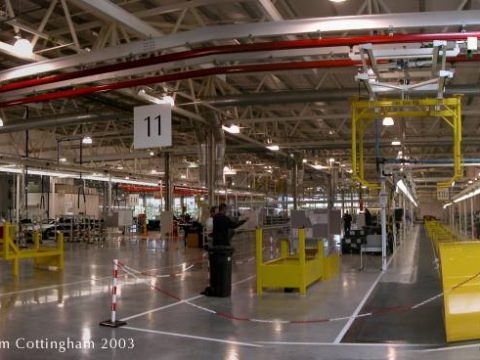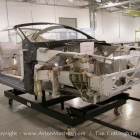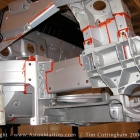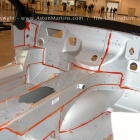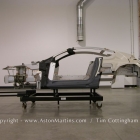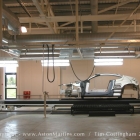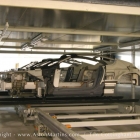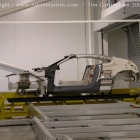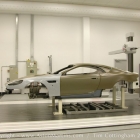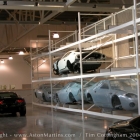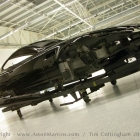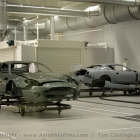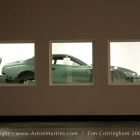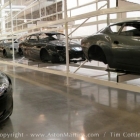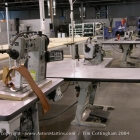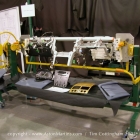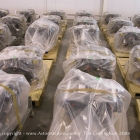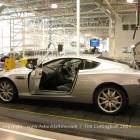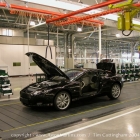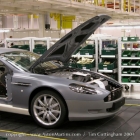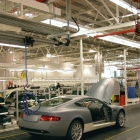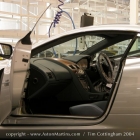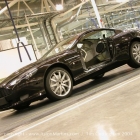I have tried to follow the route that the chassis takes as it is being built, which is not necessarily how you would see it if you were fortunate to visit the factory as a customer. I will add that there are occasional organised factory visits for AMOC members. If you wish to join (you don’t need to own an Aston at all), please visit www.amoc.org for details.
Body-in-White. The main body structure of the DB9 (VH chassis), a bonded monocoque of Die-cast, extruded and stamped aluminium, is manufactured by Hydro Automotive in Worcester (now known as Holden Aluminium Worcester). Before construction begins, it is heated to ambient temperature and is cleaned and primed in those areas which receive adhesive. The only robot ever to be used in Aston Martin production, quaintly named ‘James Bonder’ precisely applies an adhesive to the structure. To this are then added the aluminium body panels at the framing station, designed to hold them firmly in place whilst applying heat to cure the adhesive. The front wings, doors, bonnet and boot lid which are all composite, are fitted by hand. The panelled body structure is known as the ‘body-in-white’ .
CMM shop. Every Body in white is closely inspected before going on to the paint shop. A sophisticated measuring machine called the Co-ordinate Measuring Machine (CMM) is employed to check every dimension and panel gap together with critical visual inspection. Any imperfections are corrected by specialist craftsmen before painting can begin. The Paint Shop. An Aston Martin paint finish has always been considered the best of any motor car. And the DB9 is no exception – indeed, AM aim to exceed the best offered by other so-called prestige manufacturers by 10%. Cars are still very much spray painted by hand, a process that takes up to 25 hours per car. The bumpers, sills and other parts are loaded onto a rolling jig together with the bodyshell so that every part is painted at the same time to ensure the best possible finish. Each car receives two coats of colour matched primer which is hand flatted before two coats of colour and a clear coat which is again hand polished. Again, the car is inspected and any imperfections are corrected. The paint shop is a totally enclosed, dust free environment, yet is fully visible to visitors through generous windows. Once painted, the bodies are stored on a pair of three storey shelving units with sufficient storage for 15 cars each. Movement is by an Auto Guided Vehicle (AGV). the best way I can describe the AGV, which I have seen working is a fully automatic fork lift the glides under it’s own power and is guided precisely by laser. As soon as a space becomes available on the assembly line, the AGV collects the painted body and moves it to the beginning of the line. At the same time, all of the customer specified parts are also delved to the line to join the body as it passes each station. Trim, engines and sub assembly. When I took these pictures of the trim shop area at Gaydon only a few machines had been moved into place; more for show than a working facility. My more recent visit saw the trim shop as a hive of activity. Each seat is trimmed by hand from 54 pieces of leather all taken from the same hide to give a perfect match. The facia is assembled outside the car, fully tested and trimmed with leather before fitted to the bodyshell on the assembly line. For much of the first year of DB9 production engines were built by Cosworth Technology until the Aston Martin Engine Plant, Cologne, Germany came online in September 2004. The Assembly Line. Below is the view that you get of the main assembly area for the DB9 if you look to your right after entering the production area. This picture give only a small impression of the place as it now has far more machinery and cars in various states of finish and areas dealing with sub assembly. Parts such as the doors, sills and bumpers are removed from the main shell both to avoid damage as the main assembly takes place and also to allow for sub assembly. The powertrain, consisting of engine, torque tube, transaxle, brakes, dampers, exhausts and cooling pack is assembled as a separate unit. The body and powertrain are finally brought together halfway along the final assembly line; the body is lowered in an overhead sling, whereas the powertrain is lifted by a hydraulic ram. The doors are sub-assembled complete with glass, winding mechanisms and interior trim. These are one of the last items fitted to the car before it is finished. Just before the car is taken to the finishing line, it is fully scrutinised and also driven on the Aston Martin test track that is at the factory. There is also a rectification area which is one of the smallest parts of the factory where small problems are sorted before the car is delivered out to the dealers. The DB9 takes approximately 200 man hours to build.
